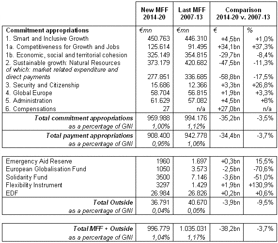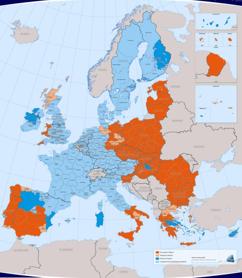11/02/2013
FSG A.T.
 The European Council finally agreed a budget for the EU up to 2020 last Friday following Marathonian negotiations. The budget for the EU’s Multiannual Financial Framework (MFF) 2014-2020 is one of continuity, albeit affected by significant reductions in real terms, and falling short of the budget proposed by the European Commission. For the first time in the EU’s history, the overall ceiling of a MFF has been reduced compared to the previous MFF. Potentially major losers of the MFF 2014-2020 are persons and groups in situations of poverty and exclusion.
The European Council finally agreed a budget for the EU up to 2020 last Friday following Marathonian negotiations. The budget for the EU’s Multiannual Financial Framework (MFF) 2014-2020 is one of continuity, albeit affected by significant reductions in real terms, and falling short of the budget proposed by the European Commission. For the first time in the EU’s history, the overall ceiling of a MFF has been reduced compared to the previous MFF. Potentially major losers of the MFF 2014-2020 are persons and groups in situations of poverty and exclusion.The European Council finally agreed a budget for the EU up to 2020 last Friday following Marathonian negotiations and in a context marked by persistent economic crisis, fiscal austerity, and a growing gap between ‘core’ and ‘peripheral’ EU member states in terms of growth, employment and levels of debt. The budget for the EU’s Multiannual Financial Framework (MFF) 2014-2020 is one of continuity, albeit affected by significant reductions in real terms, and falling short of the budget proposed by the European Commission. For the first time in the EU’s history, the overall ceiling of a MFF has been reduced compared to the previous MFF. Such ‘moderation’ was justified by the European Council as a reflection of the ‘consolidation of public finances at national level’.
The maximum possible commitments of the 2014-2020 MFF has been set at EUR 959.99 billion (or 1.00% of the EU’s total GNI), down from EUR 994.18 billion (1.12% of the EU’s total GNI) in the current MFF (2007-2013). This signifies a 3.4% reduction compared to the current MFF.
The ‘Smart and Inclusive Growth’ heading, which frames the EU Cohesion policy and Structural Funds, registers a 1% increase, from EUR 446,310 billion to EUR 450,763 billion, demonstrating the strategic importance of education, technology and innovation for EU growth. Nonetheless, this increase in the total ‘smart and inclusive growth’ envelope veils a substantial redirection of funds away from the ‘Cohesion’ sub-heading (from EUR 354.815 billion to EUR 325.149 billion, an 8.4% decrease) towards the ‘Competitiveness for Growth and Jobs’ sub-heading (from EUR 91.495 billion to EUR 125.614 billion, a 37% increase chiefly aimed to support research and innovation as well as the Erasmus programme). The European Commission had proposed a EUR 376 billion envelope for the ‘Cohesion’ sub-heading. As such, potentially major losers of the MFF 2014-2020 are persons and groups in situations of poverty and exclusion.

Agreed MFF 2014-2020
Through the European Regional Development Fund (ERDF), the European Social Fund (ESF) and the Cohesion Fund (CF), the future Cohesion policy will pursue the following goals: "Investment for growth and jobs" in Member States and regions, to be supported by all the Funds; and "European territorial cooperation", to be supported by the ERDF.
Within the ‘Cohesion’ sub-heading, resources allocated to the ‘Investment for growth and jobs’ goal will amount to EUR 313.197 billion, distributed among 3 types of regions, defined on the basis of how their GDP per capita, measured in purchasing power parities and calculated on the basis of EU figures for the period 2007 to 2009, relates to the average GDP of EU-27. The allocations will be made accordingly:

Eligible regions in current EU Cohesion Policy. 'Transition regions' in the next MFF will group 'Phasing Out' and 'Phasing in' regions of the present MFF.
However, the poorer EU Member States will receive a larger share of the total ‘Cohesion’ envelope than in the current MFF, with the provision for additional allocations to countries disproportionately affected by the crisis: Greece, Portugal, Spain, Italy and Ireland. In the case of Spain, this additional allocation will amount to EUR 1.824 billion, out of which EUR 500 billion for Extremadura. A premium of EUR 1,100 per unemployed person per year will be added for transition regions (in Spain: Valencia region, Murcia, Castile-León, Asturias, Canarias, Melilla and Ceuta).
One further avenue for flexibility, among others, is the Review Clause for Cohesion funds, which will allow for an adjustment of total allocations to all countries on the basis of a review of allocations by the Commission in 2016 (par. 54) "to take into account the particularly difficult situation of … countries suffering from the crisis". It is expected, furthermore, that Spain will receive a total of EUR 3,724 billion out of Cohesion funds, a reflection of the rapid impoverishment of Spain: its GDP has contracted 5% since the beginning of the crisis.
Also under the Cohesion subheading, a Youth Employment initiative in the framework of the Youth on the Move flagship initiative has been created with an envelope of EUR 6 billion, half of which will be financed out of the European Social Fund and the other half from a new budget line. It will be open to all regions with levels of youth unemployment above 25%. On its side, the food aid scheme for the most deprived people will be allocated EUR 2.5 billion, putting it on a sustainable basis.
In order to ensure better spending, new elements are introduced: for Member States, a macro-economic conditionality to increase synergy between cohesion, funding and economic governance; and for projects, incentives for results, with money set aside for the best performers.
Links